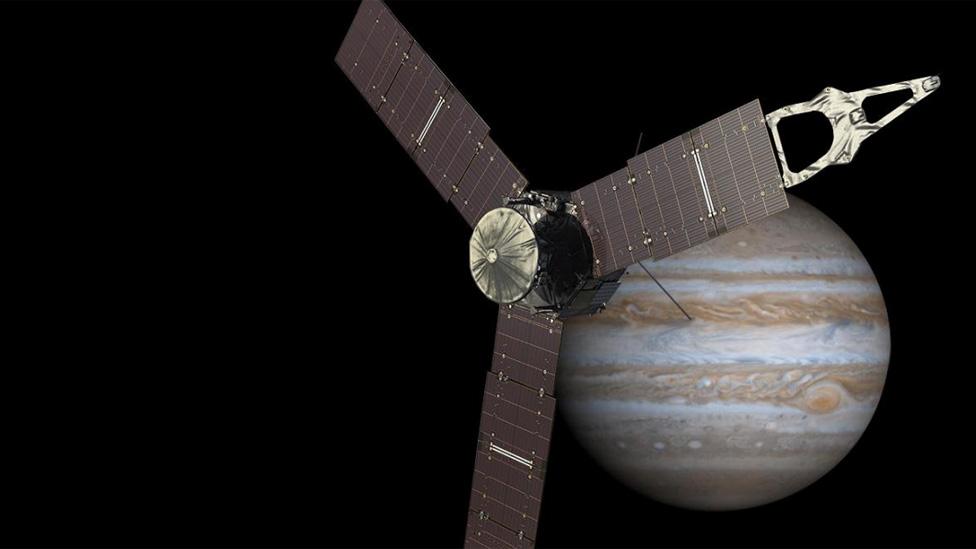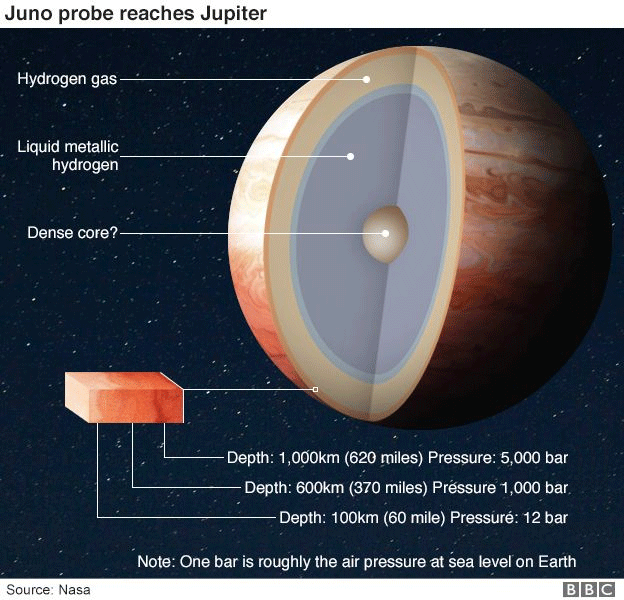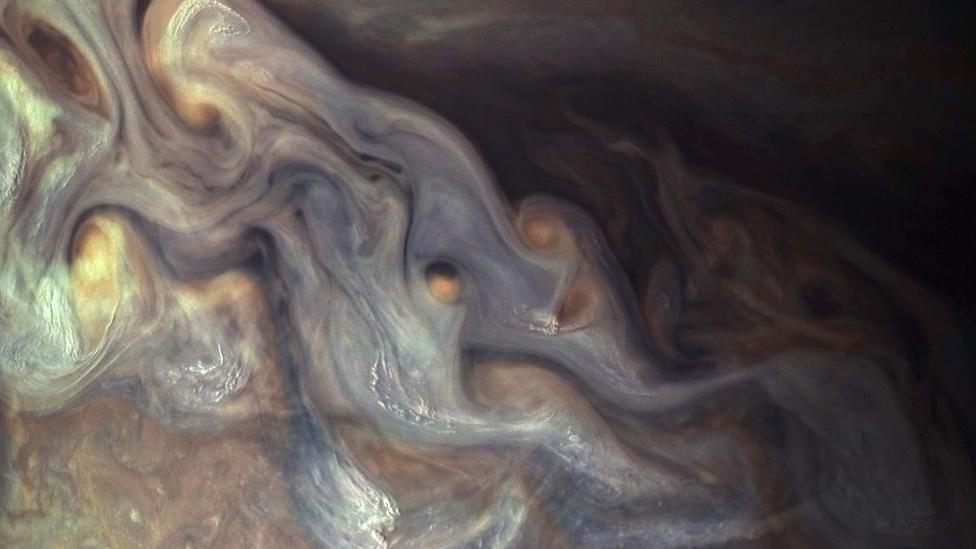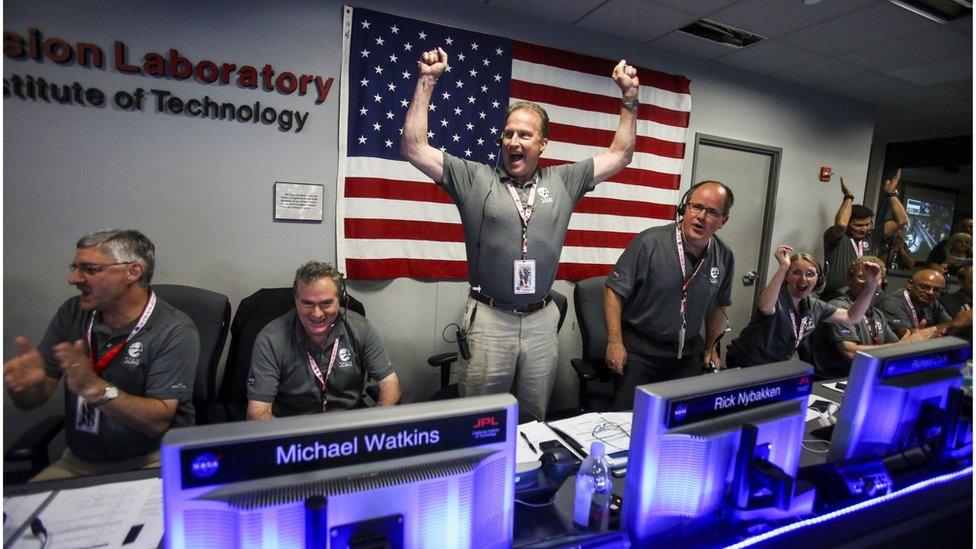Planet Jupiter's winds run deep
- Published

The central cyclone at the planet's north pole is encircled by eight other storms
We are finally getting a look inside the biggest planet in the Solar System - Jupiter. And it is very strange.
The American space agency's Juno probe has been studying the variations in the pull of gravity as it flies across the giant world's banded atmosphere.
These measurements betray the movement of mass within Jupiter, and that gives scientists clues to its structure.
The latest data reveals the activity of those familiar, colourful, wind-sculpted bands extends 3,000km down.
That's on a planet which is 140,000km wide. "This solves a long-time mystery," said Juno scientist Tristan Guillot from the Côte d'Azur Observatory, France.
"For over 40 years we didn't know whether the bands would go all the way to the centre, or whether they were just skin deep. Three thousand km is actually quite deep. It's 1% of the mass of the planet. Jupiter's very big so it's about three Earth masses that are involved in this motion.
"This is all really important for understanding atmospheric dynamics, not just on Jupiter but on other gaseous planets like Saturn, Uranus and Neptune and also the exoplanets we're now discovering," he told BBC News.
Dr Guillot is an author on a slew of papers in the journal Nature, external describing the latest observations from Juno.
In particular, he led the study, external that examined what may lurk even deeper than the roots of the bands.
This is a domain where the predominant gases of hydrogen and helium start to transition under immense pressure into exotic fluid states. And in contrast to the east-west motions that are seen at the surface, the entire interior mass of material appears to rotate in a uniform way - as if a solid body.
It is within this body that Jupiter's immense magnetic field is produced.
"It's generated a bit deeper down when hydrogen becomes so highly compressed that it becomes a metal. And then charges can move easily and you can have, with convection, what's called a dynamo effect," said Dr Guillot.
The jury's still out on whether Jupiter has a rocky core. This determination is one of the key questions Juno was sent to answer. Early investigations suggest it may do, but not in the sense that is easily understandable.
It could be quite diffuse; "diluted" or "partially mixed with the interior", the French scientist says.

Artwork: Juno arrived at Jupiter in July 2016
Clarity should come the longer the mission runs. The US space agency will soon need to approve a funded extension to Juno's stay.
Scientists would like a minimum coverage of 34 orbits (one orbit around Jupiter takes 53 days), which would take the mission, which arrived in July 2016, through to 2021.
It would permit the researchers to fully map the planet's magnetic field and to pursue other questions such as the precise depth of Jupiter's Great Red Spot.
Microwave observations indicate the huge, long-lived storm in the southern hemisphere reaches down at least 350km into the atmosphere. Additional gravity measurements may find it descends further still.
Juno so far has been a tour de force, bringing a very difference perspective on Jupiter to those spacecraft that have visited the gas giant in the past.
The way that the probe flies around the planet, from pole to pole, means, for example, that it can see storms at high latitudes that simply are not visible from Earth-based telescopes.
One of the papers published in Nature this week notes the interesting patterns in play.
At the north pole, eight cyclones rotate around a single storm, whereas at the south pole, five cyclones encircle the central storm.

After decades of debate we now know these banded flows extend 3,000km deep
The origins of these cyclones and how they persist without merging, or letting another storm muscle in, remain unknown, however.
Alberto Adriani, the lead author on the paper, external from the Institute for Space Astrophysics and Planetology, Italy, said: "Each one of the northern cyclones is almost as wide as the distance between Naples, Italy, and New York City - and the southern ones are even larger than that. They have very violent winds, reaching, in some cases, speeds as great as 220mph (350km/h).
"Finally, and perhaps most remarkably, they are very close together and enduring. There is nothing else like it that we know of in the Solar System."
Commenting on all the latest work, Leigh Fletcher, from Leicester University, UK, said Juno was really now starting to deliver on its promise.
He believes that what we have learned at Jupiter, and at Saturn with Nasa's Cassini probe, will heighten the desire to send missions to the other giants in the Solar System.
"We've been lobbying for years to go to Uranus and Neptune, and we're hoping that in the next few years the Americans will put it right at the top of their agenda, after the next mission to Jupiter's moon Europa.
"That would mean by the late 2020s or early 2030s, we'd have a real mission to head out to those planets."


Jupiter is 11 times wider than Earth and 300 times more massive
It takes 12 Earth years to orbit the Sun; a "day" is 10 hours long
In composition, it resembles a star; it's mostly hydrogen and helium
Under pressure, the hydrogen assumes a state similar to a metal
This "metallic hydrogen" is likely the source of the magnetic field
Most of the visible cloud tops contain ammonia and hydrogen sulphide
Jupiter's low-latitude "bands" play host to very strong east-west winds
The Great Red Spot is a giant storm vortex wider than planet Earth

Jonathan.Amos-INTERNET@bbc.co.uk, external and follow me on Twitter: @BBCAmos, external
- Published12 December 2017

- Published25 May 2017

- Published5 July 2016
